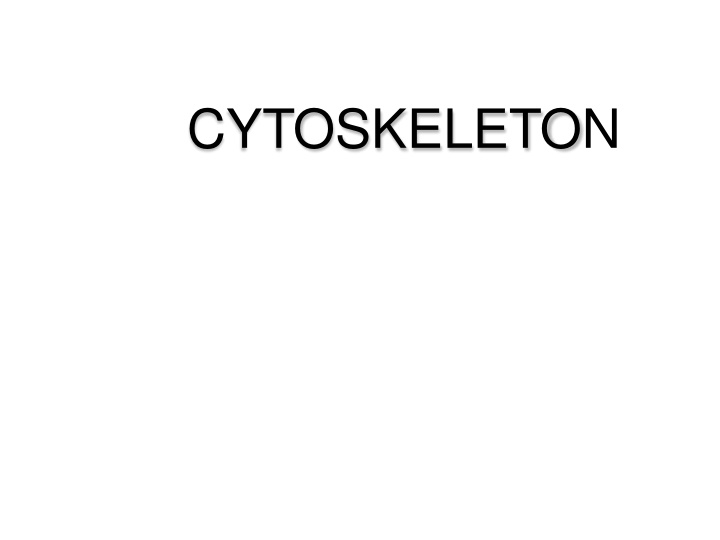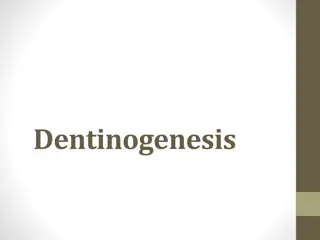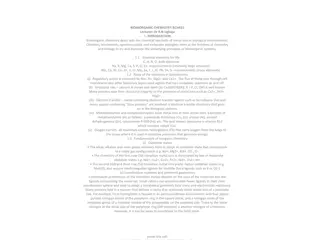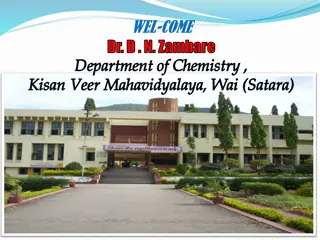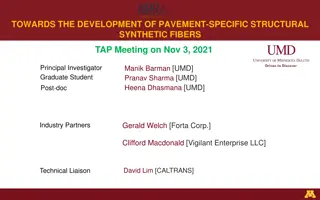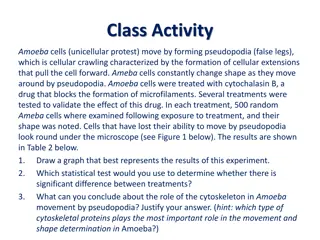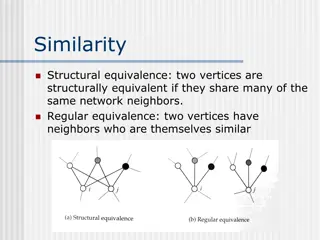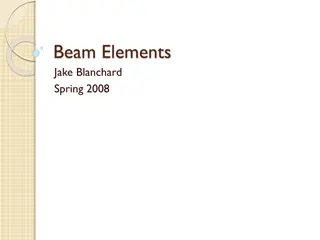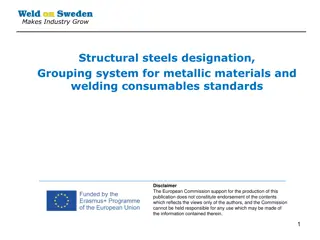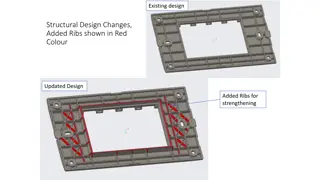The Cytoskeleton: History, Introduction, and Structural Elements
The cytoskeleton, a crucial framework within cells, maintains cell shape and enables various dynamic functions such as intracellular transport, cell division, and signal transmission. Comprised of microfilaments, intermediate filaments, and microtubules, the cytoskeleton plays a vital role in cellular architecture. This article delves into the history of cytoskeleton discovery, its fundamental components, and its significance in cellular processes.
Download Presentation

Please find below an Image/Link to download the presentation.
The content on the website is provided AS IS for your information and personal use only. It may not be sold, licensed, or shared on other websites without obtaining consent from the author.If you encounter any issues during the download, it is possible that the publisher has removed the file from their server.
You are allowed to download the files provided on this website for personal or commercial use, subject to the condition that they are used lawfully. All files are the property of their respective owners.
The content on the website is provided AS IS for your information and personal use only. It may not be sold, licensed, or shared on other websites without obtaining consent from the author.
E N D
Presentation Transcript
CONTENTS History History & & Introduction Introduction of ofCytoskeleton. Structural elements Structural elements of ofCytoskeleton. Types Types of of cell cell junctions junctions & & its itscomponents. Epithelial Epithelial connective connective tissue Clinical Clinicalconsiderations. considerations. References. References. Cytoskeleton. Cytoskeleton. components. tissueinterface. interface.
HISTORY In 1903, Nikolai K Koltsav proposed that the shape of cells was determined by a network of tubules which he termed theCytoskeleton. The term Cytosquelette (in french) was first introduced by French embryologist Paul Wintrebert in 1931.
INTRODUCTION Every cell hasasupporting framework of minute filaments and tubules, known as the Cytoskeleton Cytoskeleton, which maintains the shape and polarity of thecell. The various cells&tissues that compose the oral cavity are complex entities that exhibit unique developmental and functionalcharacteristics. However,they have several structural features in common with othercells. The Cytoskeleton is a cellular scaffolding or skeleton contained within a cells cytoplasm and is made out ofprotein.
The cell membrane and the intracellular organelles are not rigid or static structures but are in a constant state of movement to accommodate processes such as endocytosis, phagocytosis and secretion. Muscle cells are highly specialised for contractility. In addition, cell division is a process which involves extensive reorganisation of cellularconstituents. The cytoskeleton incorporates features which accommodate all these dynamic functions. Cells possess a cytoskeleton that provides : 1.a structuralframework 2.facilitates intracellulartransport, 3.plays a major role in cell division, 4.supports celljunctions 5.transmits signals about cellcontact, adhesion & permitsmotility.
The three structural elements of the cytoskeleton are: Microfilaments, Intermediate filaments,and Microtubules. All are dynamic structures assembled from protein subunits and alsocontain accessory proteins linking these structures to one another, to plasma membrane & to the membranes of intracellularorganelles. Microfilaments: Microfilaments: Microfilaments are 6 to 8nm in diameter and consist of globularactin ( G-actin) moleculespolymerized into long filaments which are Interwined in a helix, creating filamentous form of the protein ( F-actin).
They form tracks for the movement of myosin and serveas intracellular muscles for maintenance of cell shape, movement, and contractility. They are typically present at the plasma membrane ; therefore the periphery of a cell contains the highest concentration of microfilaments. Beneath the plasma membrane actin in association with other transmembrane and linkingproteins ( filamin) forms a supporting meshworkcalled cell cell cortex cortex which protects againstdeformation & yet can be rearranged to accommodate changes in cellmorphology.
They are presentasthe structural core ofmicrovilli, filopodia, andlamellipodia. Actin interacts with the other two components of the cytoskeleton. During the telophaseofmitosis theplasmamembrane around the spindle equator becomes indented to form a circumferential cleavagefurrow around the cell where a ring of microfilaments organize themselves beneath this furrow and constricts the cell to becleaved into two daughtercells.
Intermediate filaments 1.Intermediate filamentsareapproximately 10 nmin diameter and have a diverse proteincomposition. 2.They are not contractile(static) but are importantin the maintenance of cell shape and contact between adjacent cells and the extracellularmatrix. Assembly Assembly of of intermediate intermediatefilaments: filaments: .
In humans more than 50 different types of intermediate filaments have beenidentified. But these can be divided into 6 different groups based on similarities between their aminoacidsequences. They are most commonly known as support system or scaffolding for thecell. The keratinfilaments of epithelial cellsare tightly anchored to the plasma membraneat two areas of specialized cellcontacts,desmosomes and hemidesmosomes.
In epithelial cells, intermediate filaments consist of cytokeratins. cytokeratins. These filaments form bundles, called tonofilaments, which anchor ontodesmosomes. They type I (acidic) and type II (neutral/basic) keratin, which copolymerize to formfilaments. The type III intermediate filament proteins include vimentin whicharepresent in cells of mesenchymal origin, such as fibroblasts and osteoblasts.. Another type III protein, desmin desmin, is specifically expressed in muscle cells, where it connects the Z discs of individual contractileelements. other type III intermediate filament protein is glial acidic protein acidic protein in glialcells. vimentin glial fibrillary fibrillary
The type IV intermediate filament proteins includethe three neurofilament neurofilament (NF) (NF) proteins. These proteins form the major intermediate filaments of many types of mature neurons. They are particularly abundant in the axons of motor neurons and are thought to play a critical role in supporting theselong, thin processes, which can extend more than a meter inlength. The type V intermediate filament proteins are the nuclear components of the nuclear envelope and aid in the disintegration of nuclear envelope in the late prophase due to phosphorylation of the nuclear lamins which results in disassembly of the nuclear lamina and breakdown of the nuclear envelope duringmitosis. The single type VI intermediate filament protein nestin earlier during the development of neurons, in stem cells of the central nervous system ( can be used as a stem cellmarker). proteins. nuclear lamins. lamins. Theyare nestin is expressed even
7. Their expression patterns have been used to determine the relationship between cell types and as an indication of the origin of various tumors. Microtubules Microtubules are tubular or cylindrical structures with an average diameter of 25nm. They are composed of the protein tubulin have two subunits alpha & beta tubulin which polymerise to form a hollow tubule when seen in a cross section 13 tubulin molecules make up acircle. tubulin which
Microtubules originate from a specialised microtubule organising centre, thecentriole centriole, found in the centrosome centrosome which is a zone of cytoplasm distinguishable by its different texture, usually located adjacent to the nucleus in acell. The centrosome, consists of a pair of centrioles; Each centriole consists of nine triplets of microtubules arranged in cylindrical manner. The two cylinders are arranged at right angles to oneanother.
Centrosome acts as a nucleation centre for microtubularfunction. They organise the microtubules of the cell spindle during cell division which contols the distribution of chromosomes to daughtercells. several microtubules radiate from the centrosome towards the cell periphery.
Microtubule Microtubule- -associated structure and include capping growing ends of thetubules. The motorproteinsdynein tubules towards and away from the cell centre, and attaches it to membranous organellesthereby providing movement in thecytoplasm. associated proteins capping proteins proteins (MAPs proteins, which stabilise the MAPs) stabilise the tubular dynein andkinesin kinesin move along the
In summary the micro filaments and micro tubules are labile and dynamic structures (except in muscle & cilia where they perform specialisedfunctions). Where as Intermediate filaments serve a more static supportingfunction.
Cell Junctions When cells are attached to one another, and sometimes with the extracellular matrix, specialized junctions form at specific sites on the long term contacting cellmembranes. These specialized junctions are classified as follows: 1. 1. Tight Tight junctions (zonula junctions (zonulaoccludens) 2. 2. Adhesive Adhesivejunctions junctions a. a.Cell Cell- -to to- -cell cell i. i.Zonula Zonulaadherens adherens ii. ii.Macula Macula adherens adherens(desmosome) b. b.Cell Cell- -to to- -matrix matrix i. i.Focal Focaladhesions adhesions ii. ii.Hemidesmosomes Hemidesmosomes 3. 3. Communicating Communicating (gap) (gap)junctions occludens) (desmosome) junctions
Components of cell junctions On the molecular level, intercellular junctions consist of threecomponents: 1. 1. Transmembrane adhesive Transmembrane adhesiveprotein 2. 2.Cytoplasmic Cytoplasmic adapter protein, adapter protein,and 3. 3. Cytoskeletal Cytoskeletal filament. filament. protein and These three components differ depending on the type of junction.
In occluding, or tight junctions the opposing cell membranes are held Tight junctions: in close contact by the presence of transmembrane adhesive proteins arranged in anastomosing strands that encircle thecell. The intercellular space essentially is obliterated at the tight junction. The transmembrane adhesive proteins of tight junctions -Occludin (members of the claudinfamily) Insometissues Junctional Junctional adhesion molecule adhesion molecule interact homotypically with the same proteins on the adjacentcell. Cytoplasmic proteins of the tight junctions bind to actin filaments. Occludin
Several cytoplasmic proteins associate with the intracellular portions of the transmembrane proteins & theseinclude: 1.cell polarity related proteins, 2.vesicular transport relatedproteins, 3.kinases, 4.transcription factors, and a tumor suppressorprotein. They have an important role as a fence to define and maintain the two major domains of the cell membrane, the apical and baso lateralsurfaces.
The tightness of the junction to waterandions is dueto claudins present and is correlated with the number of strands of transmembraneproteins. Forexample: tight junctions joining salivary gland secretory cells have only two or three junctional strands and are relatively permeable towater, whereas those joining salivary gland striated duct cells may have six to nine strands and are relatively impermeable to water. The permeability of tight junctions in some tissues may be regulated by certain neurotransmitters andhormones.
Adhesive junctions: CELL-CELL JUNCTION: Adhesive junctions hold cells together or anchor cells to the extracellular matrix. The intercellular space in cell-cell adhesive junctions is maintained at approximately20nm. Adhesive junctions also are important in cellular signaling. Their cytoplasmic components may interact with the cytoskeleton, triggering changes in cell shape or motility. In cell-cell adhesive junctions the principal transmembrane proteins are members of the Cadherin Cadherinfamily. Cadherins are calcium ion dependent proteins that interact homotypically with cadherins on the adjacent cell.
The cytoplasmic adapter proteins are members of the Catenin family. Catenins interact withthetransmembrane cadherin molecule, the cytoskeleton, and with a number of other proteins, including kinases, and tumor suppressor molecules that are associated with adhesivejunctions. ZONULA ZONULAADHERENS ADHERENS: In zonula adherensthecadherin familyis E E- -cadherin cadherin. - -and and - -catenin catenin are the cytoplasmic adapters. Actin Actinfilaments filaments are the cytoskeletalcomponent
The catenins and actin filaments are concentrated on the cytoplasmic side of the cell membrane at the zonula adherens to form a dense web that is continuous with the terminal web of actin at the end of the cells. Another transmembrane adhesive protein present in the adherens junction is Nectin Nectin, a member of the immunoglobulin superfamily.
Nectin has an important role during junction formation, establishing the initial adhesion site and recruiting E-cadherin and other proteins to thejunction. Other cytoplasmic proteins associated with the zonula adherens include p120 catenin , a signaling molecule associated with E- cadherin that is important in stabilizing thejunction; Afadin, which links nectin to the actin cytoskeleton; vinculin and - actinin, which are actin-binding proteins; and ponsin, which links afadin andvinculin.
DESMOSOME: MACULA MACULA ADHERENS ADHERENS / /DESMOSOME In the desmosome the cadherins are desmoglein desmocollin desmocollin. The interaction of these transmembrane proteins with the adjacent cell results in a dense line in the middle of the intercellular space at thedesmosome. The catenins are desmoplakin, plakoglobin desmoplakin, plakoglobin, and plakophilin which form an electron-dense plaque on the cytoplasmic side of thedesmosome. This plaque serves as an attachment site for the cytoskeletal components, which in the case of the desmosome are intermediate filaments. desmogleinand plakophilin,
CELL-MATRIX JUNCTION Cell-matrix junctions have a structural organization similar to that of cell-cell adhesive junctions, but they use different molecular componentsand attach thecell to the extracellularmatrix. 1. FOCAL FOCALADHESIONS: ADHESIONS: The Transmembrane componentis a member of the Integrin molecules. Integrins are heterodimers of different alpha and beta subunits that occur in different combinations with specificity for various extracellular matrix molecules. Cytoplasmic adapter proteins, include the actin binding proteins - -actinin, vinculin, actinin, vinculin, and andtalin. talin. Integrin family of adhesion They link the transmembrane integrins to the actin cytoskeleton. Binding of the integrin to collagen, laminin, fibronectin, and other extracellular matrix proteins results in recruitment and remodeling of the actin cytoskeleton. .
2. Hemidesmosomes: 1.Hemidesmosomes through additional extracellular molecules to the rest of the extracellular matrix. 2.The transmembrane adhesive molecules are the Integrin 6 4 6 4, which binds specifically to the basal lamina glycoprotein laminin, and collagen XVII (also identified asBP180). 3.The cytoplasmic adapter proteins are the bullous antigen antigen 230 230 (BP230) and plectin plectin, form a dense plaque on the cytoplasmic surface of the hemidesmosome, which functions as an attachment site for intermediatefilaments. linkthecell tothebasal lamina and, Integrin bullous pemphigoid pemphigoid
GAPJUNCTIONS: Gap junctions are plaque-like regions of the cell membrane where the intercellular space narrows to 2 to 3nm. Transmembrane proteins are of the connexin which form aqueous channels between the cytoplasm of adjacent cells. connexin family, These proteins have specific tissue and cellular distributions and confer differing permeability properties to the gap junctions. Six connexin molecules form a connexon, which hasa central channel approximately 2 nm indiameter.
The connexons in one cell pair with connexons in the adjacent cell to create a patent channel. Small molecules, such as ions and signaling molecules, can move readily from one cell toanother. Gap junctions electrically couple cells and allow for a coordinated response to a stimulus by the cells that are interconnected.
EPITHELIUMCONNECTIVE TISSUE INTERFACE All epithelia are separated from the underlying connective tissuebyalayerofextracellularmatrixorganizedasathin sheetimmediatelyadjacenttotheepithelialcells. This is basal lamina, which is a product of the epithelium and connectivetissue. The basal lamina, along with hemidesmosomes attaches the epithelium to the underlying connectivetissue. Functions as a filter to control the passage of molecules between the epithelium and connective tissue, and acts as a barrier to cellmigration.
The basal lamina also has important signaling functions, which are essential for epithelial differentiation and the development and maintenance of cellpolarity. The basal lamina has an overall thickness of 50 to 100nm. It consists of two structural components, the lamina lucida (clear zone) adjacent to the basal cell membrane, and the lamina densa(dark zone), In epithelia, there is a third layer, the lamina fibroreticularis closely associated with the laminadensa. The lamina lucida is a 20-40 nm wide glycoprotein layer that attach the cell to thebasallamina, and contains laminin 332& BP 180 antigenandalso interacts with portions of hemidesmosome-associated membrane proteinsintegrin.
The lamina densa consists chicken wire network of polymers of type IV collagenandlaminins. Additional proteins suchas heparansulfateproteoglycan and fibulin are alsopresent. Fibronectin, an adhesive glycoprotein, type III collagen (reticular fibers), typeVIIcollagen (anchoring fibrils) secretedby fibroblasts present in fibroreticularis and help maintain the attachment of the basal lamina to the underlying connectivetissue. Mostofthebasallaminacomponentsaresynthesizedbythe epithelium (some components of the lamina fibroreticularis areproducedbyconnectivetissuecellssuchasfibroblasts).
CLINICALCONSIDERATIONS: Gene mutations that interfere with the normal assembly of keratin filaments ( k5 & k14) resulted in Epidermolysis bullosa simplex ,a serious blistering skin disorder. Studiesrevealedthatmutationsinotherkeratinswereresponsibleforseveral otherinherited skin diseases,whichare similarly characterized byabnormal fragilityofepidermalcells. Amyotrophic lateral sclerosis (ALS) also known as Lou Gehrig's disease results from progressive loss of motor neurons, which in turn leads tomuscle atrophy, paralysis, and eventual death is characterized by the accumulation and abnormal assembly ofneurofilaments. Cell-cell and cell-matrix junctions have important roles in thedifferentiation, development, and function of normal cells, tissues, andorgans.
However, the functions of these junctions may be altered or disrupted by genetic abnormalities of junctional or cytoskeletal proteins or by autoimmune diseases in which circulating antibodies to junctional proteins arepresent. Mutations of connexin connexin genes have been identified as the bases for certain types of deafness, congenital cataracts, a demyelinating disease(Charcot-MarieTooth),and oculodentodigitaldysplasia, a disease that exhibits craniofacial abnormalities, syndactyly, conductive hearing loss, and hair and nailabnormalities. Epidermolysis bullosa ( junctional , dystrophic, kindler form) have shown to be caused by mutations of the genes for various desmosomal, hemidesmosomaljunctions.
Pemphigus vulgaris and pemphigus foliaceus, blistering diseases of the oral mucosa and skin are caused by autoantibodies to desmoglein-3 and desmoglein-1, the cadherin indesmosomes. Bullous pemphigoid, results from the presence of autoantibodies to the hemidesmosomal components collagen XVII (BP180) andBP230.
